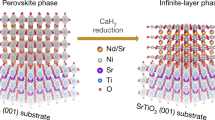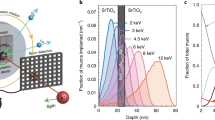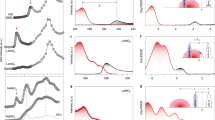Abstract
Since the discovery of high-temperature superconductivity in copper oxide materials1, there have been sustained efforts to both understand the origins of this phase and discover new cuprate-like superconducting materials2. One prime materials platform has been the rare-earth nickelates and, indeed, superconductivity was recently discovered in the doped compound Nd0.8Sr0.2NiO2 (ref. 3). Undoped NdNiO2 belongs to a series of layered square-planar nickelates with chemical formula Ndn+1NinO2n+2 and is known as the ‘infinite-layer’ (n = ∞) nickelate. Here we report the synthesis of the quintuple-layer (n = 5) member of this series, Nd6Ni5O12, in which optimal cuprate-like electron filling (d8.8) is achieved without chemical doping. We observe a superconducting transition beginning at ~13 K. Electronic structure calculations, in tandem with magnetoresistive and spectroscopic measurements, suggest that Nd6Ni5O12 interpolates between cuprate-like and infinite-layer nickelate-like behaviour. In engineering a distinct superconducting nickelate, we identify the square-planar nickelates as a new family of superconductors that can be tuned via both doping and dimensionality.
This is a preview of subscription content, access via your institution
Access options
Access Nature and 54 other Nature Portfolio journals
Get Nature+, our best-value online-access subscription
$29.99 / 30 days
cancel any time
Subscribe to this journal
Receive 12 print issues and online access
$259.00 per year
only $21.58 per issue
Buy this article
- Purchase on Springer Link
- Instant access to full article PDF
Prices may be subject to local taxes which are calculated during checkout




Similar content being viewed by others
References
Bednorz, J. & Müller, K. Possible high Tc superconductivity in the Ba–La–Cu–O system. Z. Phys. B 64, 189–193 (1986).
Keimer, B., Kivelson, S. A., Norman, M. R., Uchida, S. & Zaanen, J. From quantum matter to high-temperature superconductivity in copper oxides. Nature 518, 179–186 (2015).
Li, D. et al. Superconductivity in an infinite-layer nickelate. Nature 572, 624–627 (2019).
Anisimov, V. I., Bukhvalov, D. & Rice, T. M. Electronic structure of possible nickelate analogs to the cuprates. Phys. Rev. B 59, 7901–7906 (1999).
Chaloupka, J. & Khaliullin, G. Orbital order and possible superconductivity in LaNiO3/LaMO3 superlattices. Phys. Rev. Lett. 100, 016404 (2008).
Emery, V. J., Kivelson, S. A. & Tranquada, J. M. Stripe phases in high-temperature superconductors. Proc. Natl Acad. Sci. USA 96, 8814–8817 (1999).
Li, D. et al. Superconducting dome in Nd1−xSrxNiO2 infinite layer films. Phys. Rev. Lett. 125, 027001 (2020).
Zeng, S. et al. Phase diagram and superconducting dome of infinite-layer Nd1−xSrxNiO2 thin films. Phys. Rev. Lett. 125, 147003 (2020).
Lee, K.-W. & Pickett, W. E. Infinite-layer LaNiO2: Ni1+ is not Cu2+. Phys. Rev. B 70, 165109 (2004).
Botana, A. S. & Norman, M. R. Similarities and differences between LaNiO2 and CaCuO2 and implications for superconductivity. Phys. Rev. X 10, 011024 (2020).
Hepting, M. et al. Electronic structure of the parent compound of superconducting infinite-layer nickelates. Nat. Mater. 19, 381–385 (2020).
Goodge, B. H. et al. Doping evolution of the Mott–Hubbard landscape in infinite-layer nickelates. Proc. Natl Acad. Sci. USA 118, e2007683118 (2021).
Lee, K. et al. Aspects of the synthesis of thin film superconducting infinite-layer nickelates. APL Mater. 8, 041107 (2020).
Gu, Q. et al. Single particle tunneling spectrum of superconducting Nd1−xSrxNiO2 thin films. Nat. Commun. 11, 6027 (2020).
Li, Q. et al. Absence of superconductivity in bulk Nd1−xSrxNiO2. Commun. Mater. 1, 16 (2020).
Wang, B.-X. et al. Synthesis and characterization of bulk Nd1−xSrxNiO2 and Nd1−xSrxNiO3. Phys. Rev. Mater. 4, 084409 (2020).
Zhang, J. et al. Large orbital polarization in a metallic square-planar nickelate. Nat. Phys. 13, 864–869 (2017).
Lin, J. Q. et al. Strong superexchange in a d9−δ nickelate revealed by resonant inelastic X-ray scattering. Phys. Rev. Lett. 126, 087001 (2021).
Mukuda, H., Shimizu, S., Iyo, A. & Kitaoka, Y. High-Tc superconductivity and antiferromagnetism in multilayered copper oxides—a new paradigm of superconducting mechanism. J. Phys. Soc. Jpn 81, 011008 (2012).
Greenblatt, M. Ruddlesden–Popper \({{{{\rm{Ln}}}}}_{n+1}{{{{\rm{Ni}}}}}_{n}{{{{\rm{O}}}}}_{3n+1}\) nickelates: structure and properties. Curr. Opin. Solid State Mater. Sci. 2, 174–183 (1997).
Li, Q. et al. Contrasting physical properties of the trilayer nickelates Nd4Ni3O10 and Nd4Ni3O8. Sci. China Phys. Mech. Astron. 64, 227411 (2020).
Abbate, M. et al. Electronic structure and metal-insulator transition in LaNiO3−δ. Phys. Rev. B 65, 155101 (2002).
Miyatake, T. et al. Chemical substitution effect of high-Tc superconductor candidate R4Ni3O8 (R: rare-earth). JPS Conf. Proc. 30, 011061 (2020).
Wang, B. Y. et al. Isotropic Pauli-limited superconductivity in the infinite-layer nickelate Nd0.775Sr0.225NiO2. Nat. Phys. 17, 473–477 (2021).
Osada, M. et al. A superconducting praseodymium nickelate with infinite layer structure. Nano Lett. 20, 5735–5740 (2020).
Zeng, S. et al. Observation of perfect diamagnetism and interfacial effect on the electronic structures in Nd0.8Sr0.2NiO2 superconducting infinite layers. Preprint at https://arxiv.org/abs/2104.14195 (2021).
Osada, M. et al. Nickelate superconductivity without rare-earth magnetism: (La, Sr)NiO2. Adv. Mater. https://doi.org/10.1002/adma.202104083 (2021).
Zeng, S. et al. Superconductivity in infinite-layer lanthanide nickelates. Preprint at https://arxiv.org/abs/2105.13492 (2021).
Takagi, H. et al. Superconductor-to-nonsuperconductor transition in \({({{{{\rm{La}}}}}_{1-x}{{{{\rm{Sr}}}}}_{x})}_{2}{{{{\rm{CuO}}}}}_{4}\) as investigated by transport and magnetic measurements. Phys. Rev. B 40, 2254 (1989).
Wu, X. et al. Robust \({d}_{{x}^{2}-{y}^{2}}\)-wave superconductivity of infinite-layer nickelates. Phys. Rev. B 101, 060504(R) (2020).
Karp, J. et al. Comparative many-body study of Pr4Ni3O8 and NdNiO2. Phys. Rev. B 102, 245130 (2020).
LaBollita, H. & Botana, A. S. Electronic structure and magnetic properties of higher-order layered nickelates: Lan+1NinO2n+2 (n = 4−6). Phys. Rev. B 104, 035148 (2021).
Sakakibara, H. et al. Orbital mixture effect on the Fermi-surface–Tc correlation in the cuprate superconductors: bilayer vs. single layer. Phys. Rev. B 89, 224505 (2014).
Zhang, F. C. & Rice, T. M. Effective Hamiltonian for the superconducting Cu oxides. Phys. Rev. B 37, 3759(R) (1988).
Nica, E. M. et al. Theoretical investigation of superconductivity in trilayer square-planar nickelates. Phys. Rev. B 102, 020504(R) (2020).
Suntivich, J. et al. Estimating hybridization of transition metal and oxygen states in perovskites from O K-edge X-ray absorption spectroscopy. J. Phys. Chem. C 118, 1856–1863 (2014).
Li, Y. et al. Impact of cation stoichiometry on the crystalline structure and superconductivity in nickelates. Front. Phys. 9, 719534 (2021).
Kresse, G. & Furthmüller, J. Efficient iterative schemes for ab initio total-energy calculations using a plane-wave basis set. Phys. Rev. B 54, 11169 (1996).
Acknowledgements
We thank M. R. Norman and M. Mitrano for discussions. We also thank K. Lee and H. Y. Hwang for discussions and technical guidance in reduction experiments; D. Erdosy, J. Lee, N. Pappas, S. Thapa and M. Wenny for continued support in reductions; H. Hijazi at the Rutgers University Laboratory of Surface Modification for assistance in Rutherford backscattering spectrometry; and J. MacArthur for electronics support. This research was funded in part by the Gordon and Betty Moore Foundation’s EPiQS Initiative, grant no. GBMF6760 to J. A. Mundy. Materials growth and electron microscopy were supported in part by the Platform for the Accelerated Realization, Analysis, and Discovery of Interface Materials (PARADIM) under NSF Cooperative Agreement no. DMR-2039380. Electron microscopy made use of the Cornell Center for Materials Research (CCMR) Shared Facilities, which are supported through the NSF MRSEC Program (no. DMR-1719875). The Thermo Fisher Spectra 300 X-CFEG was acquired with support from PARADIM, an NSF MIP (DMR-2039380) and Cornell University. Nanofabrication work was performed in part at Harvard University’s Center for Nanoscale Systems (CNS), a member of the National Nanotechnology Coordinated Infrastructure Network (NNCI), supported by the National Science Foundation under NSF grant no. 1541959, and in part at the University of Michigan Lurie Nanofabrication Facility. This research used resources of the Advanced Light Source, a US DOE Office of Science User Facility under contract no. DE-AC02-05CH11231. G.A.P. acknowledges support from the Paul & Daisy Soros Fellowship for New Americans and from the NSF Graduate Research Fellowship grant no. DGE-1745303. G.A.P. and D.F.S. acknowledge support from US Department of Energy, Office of Basic Energy Sciences, Division of Materials Sciences and Engineering, under award no. DE-SC0021925. Q.S., S.D. and D.C.C. were supported by the STC Center for Integrated Quantum Materials, NSF grant no. DMR-1231319. B.H.G., H.P. and L.F.K. acknowledge support by PARADIM, NSF no. DMR-2039380. A.T.P. acknowledges support from the Department of Defense through the National Defense Science and Engineering Graduate Fellowship (NDSEG) Program. J. A. Mason acknowledges support from the Arnold and Mabel Beckman Foundation through a Beckman Young Investigator grant. O.E. acknowledges support from NSF grant no. DMR-1904716. A.S.B. and H.L. acknowledge NSF grant no. DMR-2045826 and the ASU Research Computing Center for HPC resources. J. A. Mundy acknowledges support from the Packard Foundation.
Author information
Authors and Affiliations
Contributions
G.A.P., Q.S., C.M.B. and J. A. Mundy synthesized the thin films with assistance from H.P. G.A.P., D.F.S. and S.D. conducted the reductions with guidance from J. A. Mason. B.H.G. and L.F.K. characterized the samples with scanning transmission electron microscopy. G.A.P., A.T.P. and A.Y. performed transport measurements using fabrication assistance from S.N. and J.T.H. G.A.P., D.F.S., Q.S., D.C.C., A.T.N. and P.S. performed X-ray absorption spectroscopy. H.L. and A.S.B. performed density functional theory calculations. E.M.N., O.E. and A.S.B. constructed the t−J model. A.S.B. and J. A. Mundy conceived and guided the study. G.A.P., A.S.B. and J. A. Mundy wrote the manuscript with discussion and contributions from all authors.
Corresponding authors
Ethics declarations
Competing interests
The authors declare no competing interests.
Additional information
Peer review information Nature Materials thanks Hai-Hu Wen and the other, anonymous, reviewer(s) for their contribution to the peer review of this work.
Publisher’s note Springer Nature remains neutral with regard to jurisdictional claims in published maps and institutional affiliations.
Supplementary information
Supplementary information
Supplementary Table 1, Figs. 1–15 and Notes 1–6.
Source Data Fig. 2
X-ray diffraction spectra.
Source Data Fig. 3
Temperature dependence of electrical resistivities and Hall coefficients.
Source Data Fig. 4
Band structure diagrams.
Rights and permissions
About this article
Cite this article
Pan, G.A., Ferenc Segedin, D., LaBollita, H. et al. Superconductivity in a quintuple-layer square-planar nickelate. Nat. Mater. 21, 160–164 (2022). https://doi.org/10.1038/s41563-021-01142-9
Received:
Accepted:
Published:
Issue Date:
DOI: https://doi.org/10.1038/s41563-021-01142-9
This article is cited by
-
Structural phase transition, s±-wave pairing, and magnetic stripe order in bilayered superconductor La3Ni2O7 under pressure
Nature Communications (2024)
-
Direct observation of strong surface reconstruction in partially reduced nickelate films
Nature Communications (2024)
-
Optimization for epitaxial fabrication of infinite-layer nickelate superconductors
Frontiers of Physics (2024)
-
Limits to the strain engineering of layered square-planar nickelate thin films
Nature Communications (2023)
-
Signatures of superconductivity near 80 K in a nickelate under high pressure
Nature (2023)



